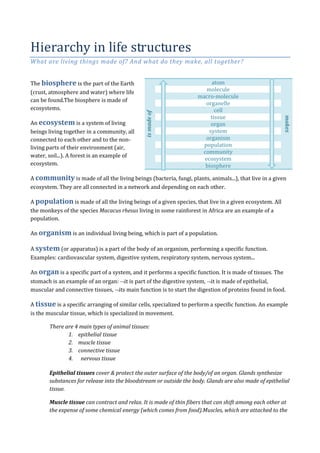
Hierarchy in life structures (text, 2nd version)
- 1. Hierarchy in life structures What are living things made of? And what do they make, all together? The biosphere is the part of the Earth (crust, atmosphere and water) where life can be found.The biosphere is made of ecosystems. An ecosystem is a system of living beings living together in a community, all connected to each other and to the non- living parts of their environment (air, water, soil...). A forest is an example of ecosystem. A community is made of all the living beings (bacteria, fungi, plants, animals...), that live in a given ecosystem. They are all connected in a network and depending on each other. A population is made of all the living beings of a given species, that live in a given ecosystem. All the monkeys of the species Macacus rhesus living in some rainforest in Africa are an example of a population. An organism is an individual living being, which is part of a population. A system (or apparatus) is a part of the body of an organism, performing a specific function. Examples: cardiovascular system, digestive system, respiratory system, nervous system... An organ is a specific part of a system, and it performs a specific function. It is made of tissues. The stomach is an example of an organ: it is part of the digestive system, it is made of epithelial, muscular and connective tissues, its main function is to start the digestion of proteins found in food. A tissue is a specific arranging of similar cells, specialized to perform a specific function. An example is the muscular tissue, which is specialized in movement. There are 4 main types of animal tissues: 1. epithelial tissue 2. muscle tissue 3. connective tissue 4. nervous tissue Epithelial tissues cover & protect the outer surface of the body/of an organ. Glands synthesize substances for release into the bloodstream or outside the body. Glands are also made of epithelial tissue. Muscle tissue can contract and relax. It is made of thin fibers that can shift among each other at the expense of some chemical energy (which comes from food).Muscles, which are attached to the is made of atom makes molecule macro-molecule organelle cell tissue organ system organism population community ecosystem biosphere
- 2. bones or make part of some organs, get shorter upon contraction and longer on relaxation, and so they can move parts of the body. Connective tissues have many different functions: they wrap organs and shape them; they provide nutrients and oxygen to other tissues; • they give strenght and resistence to bones and tendons; they protect joints from friction; they store energy-filled macromolecules… and so on! Nervous tissue carries signals (both electrically and chemically) to/from different parts of the body. Nervous tissue cells are highly specialized: they are called neurons. The central nervous system (brain & spinal cord) is all made of nervous tissue. It collects informations through sensory nerves connected to all the body parts, and in turn it sends out instructions to perform actions (moving an arm, inspiring more deeply, moving one’s eyes…) through other nerves, called motor nerves. A cell is the smallest part in living matter, it has a special structure and can be specialized for a specific function. Every living being is made of one or more cells! An organelle is a specific part of a cell, where it performs a specific function. A mitochondrion is an example of an organelle: it is the part of the cells which manages energy. Macromolecules are very big and complex molecules that form the living matter. The most important types of macromolecules are glucids (sugars), lipids (fats), proteins and nucleic acids (DNA and RNA). A molecule is a stable arranging of atoms joined together. It is the smallest part of any substance which retains the properties of that substance. A molecule of water, for example, is made of one atom of oxygen and two atoms of hydrogen linked together. An atom is the smallest part of an element. Two or more atoms, joined together (belonging to the the same element or to different elements) form the molecules. Every atom is composed of a nucleus, made of protons and neutrons, and surrounded by a cloud of electrons. Atoms form molecules The biosphere is made of ecosystems Molecules form macro- molecules Ecosystems are made of communities Macro- molecules form organelles Communities are made of populations Organelles form cells Populations are made of organisms Cells form tissues Tissues are made of cells Tissues form organs Organs are made of tissues Organs form systems Systems are made of organs Systems form organisms Organisms are made of systems Organisms form populations Cells are made of organelles Populations form communities Organelles are made of macro-molecules Communities form ecosystems Macro- molecules are made of molecules Ecosystems form the biosphere Molecules are made of atoms
